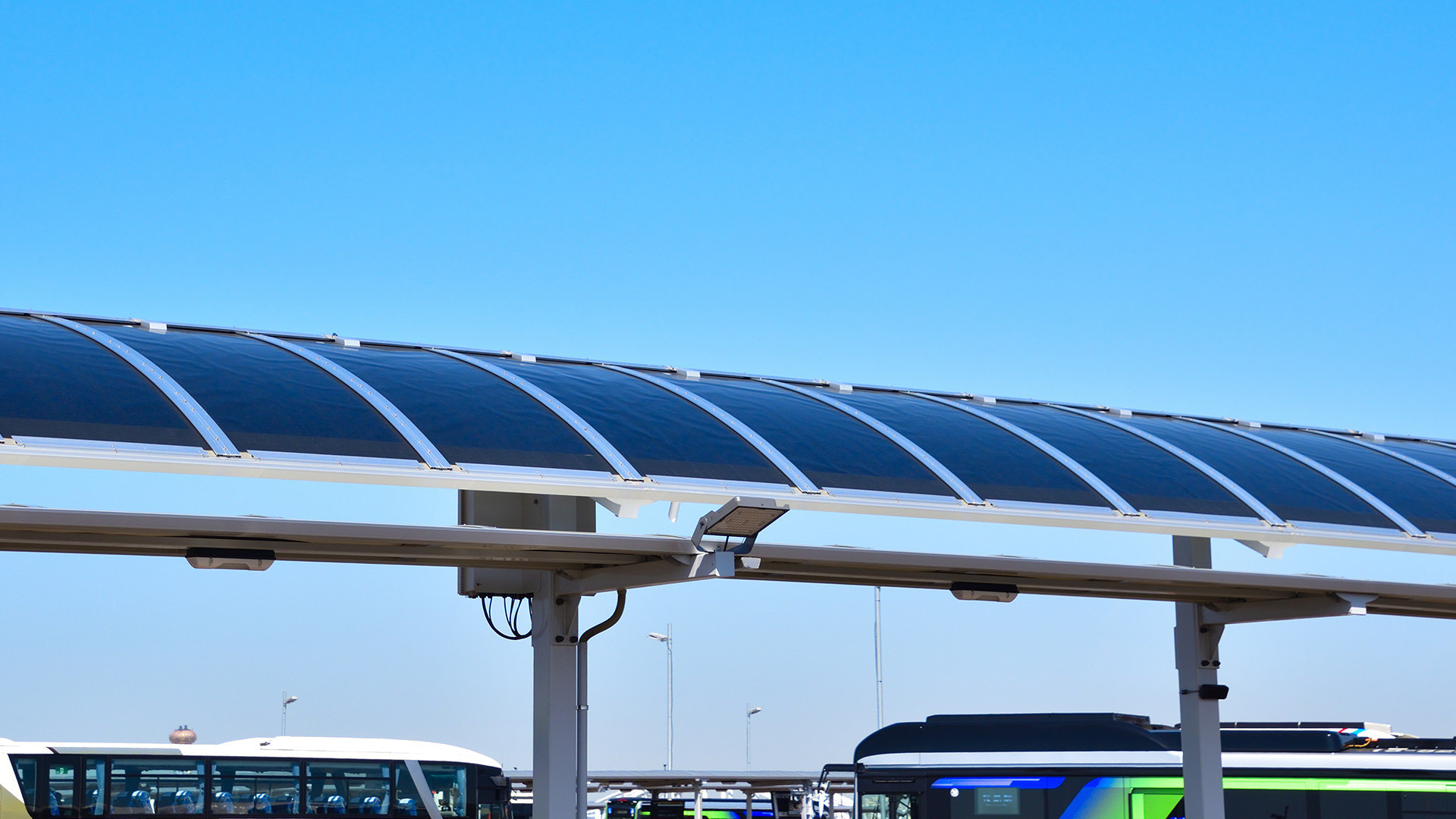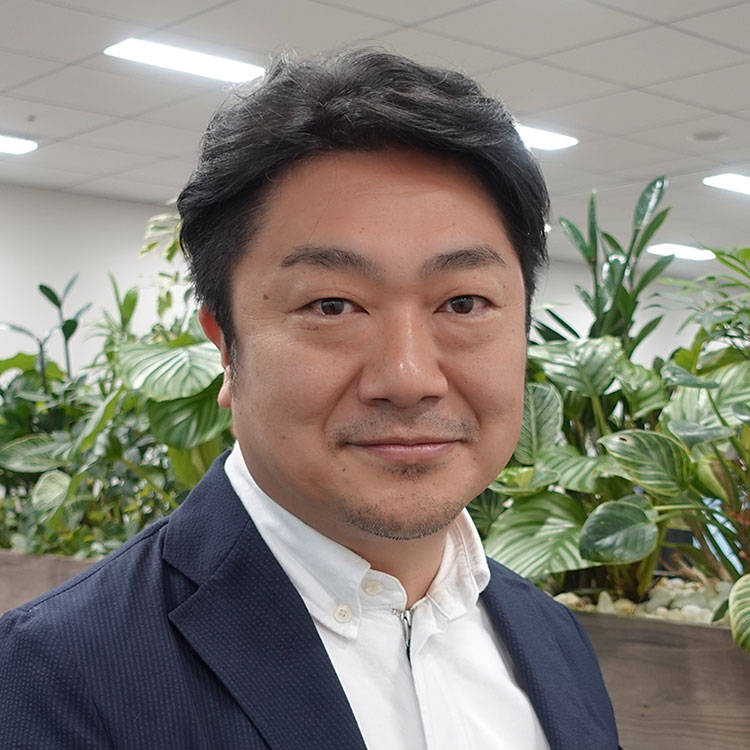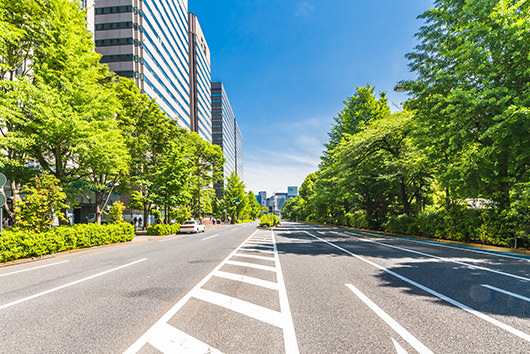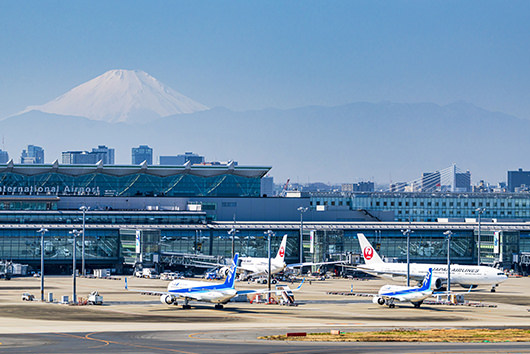In February 2025, the government approved the 7th Basic Energy Plan, setting a goal of "The ratio of renewable energy to the power supply mix in FY2040 to be about 40% to 50%". Solar power generation is expected to be at the center of this. In particular, perovskite solar cells, which are being developed, are very thin and flexible, so they are expected to expand their installation locations at once. The Prime Minister, TAKAICHI, also called for domestic energy, including perovskite solar cells, to be important as energy security, and called for immediate implementation of measures, and we talked to Tetsuo KOMORIYA, the General Manager of Renewable Energy Promotion/Development Sec., Basin Structural Dept., Land Infrastructure Div. and Chisato KAWAI, General Electricity Sec., Facility Engineering Dept., Transportation Infrastructure Div. of PACIFIC CONSULTANTS, who are considering the introduction of solar panels to existing public infrastructure.
INDEX
- Solar power generation plays a key role in renewable energy
- Perovskite solar cells attracting attention
- Anticipated introduction of solar cells into infrastructure
- PACIFIC CONSULTANTS' initiatives: Demonstration experiment begins
Solar power generation plays a key role in renewable energy
The 7th Plan, which was announced more than three years after the decision of the 6th Basic Energy Plan in October 2021, is based on changes such as the expansion of economic security importance due to Russia's invasion of Ukraine and the escalation of the situation in the Middle East, and the prospect of increasing electricity demand due to the progress of DX and GX, renewable energy as Japan's main power source. Specifically, we have set a goal to increase the renewable energy ratio to 4~50% by FY2040. The FY2023 results are 22.9%, so this is about twice as high.
Among these, solar power generation is particularly promising. All other renewable energy sources require large-scale facilities, taking at least several years to nearly 10 years from securing land to designing, construction, and trial operation before power generation can begin. Furthermore, many challenges remain before biomass can be commercialized, such as the cost of procuring, collecting, and transporting the wood used as raw material, and geothermal energy requires high initial investment and risk, as well as limitations on development locations. However, solar power generation can begin generating power in less than a year from the start of the project, as long as solar panels are installed, and therefore was positioned as a major renewable energy source in the Seventh Plan. The government aims to achieve 50% to 60% of electricity generated from renewable energy sources, or 30% of total electricity generation, by FY2040.
Energy supply and demand outlook for FY2040 (The 7th Basic Energy Plan)
| FY2023 (Preliminary Figures) | FY2040 (Forecast) | |||
| Energy self-sufficiency rate | 15.2% | Approximately 30% to 40% | ||
| Amount of generated electricity | 985.4 billion kWh | Approximately 1.1 to 1.2 trillion kWh | ||
| Power configuration | Renewable energy | Whole | 22.9% | Approximately 40% to 50% |
| (Sunlight) | 9.8% | Approximately 23 to 29% | ||
| (Wind power) | 1.1% | Approximately 4 to 8% | ||
| (Hydropower) | 7.6% | Approximately 8 to 10% | ||
| (Geothermal) | 0.3% | Approximately 1 to 2% | ||
| (Biomass) | 4.1% | Approximately 5 to 6% | ||
| Nuclear power | 8.5% | Approximately 20% | ||
| Fire power | 68.6% | Approximately 30% to 40% | ||
| Final energy consumption | 300 million kl | Approximately 260-270 million kl | ||
| Greenhouse gas reduction rate (compared to FY2013) | 22.9% | 73% | ||
Perovskite solar cells attracting attention
Among the types of solar power generation, perovskite solar cells are currently attracting the most attention. Perovskite solar cells are next-generation solar cells that use a material with a perovskite crystal structure (perovskite), which is composed of organic substances such as iodine and lead, as the power generation layer, and have many superior features compared to the currently mainstream silicon solar cells. For example, the thickness and weight of the power generation panel are about 1/20 to 1/30 of that of silicon solar cells. Furthermore, they are highly flexible and can easily conform to curved surfaces.
Furthermore, there are many other advantages to this technology, such as it being entirely domestically produced, its main raw material iodine being stably secured as Japan is the second largest producer in the world, and it does not require high temperature processing (over 1,400°C) in the manufacturing process as with silicon, and it is relatively easy to form into batteries using coating or printing.
Perovskite solar cells can be installed on roofs of factories and warehouses, as well as buildings that do not meet old earthquake resistance standards due to their insufficient load-bearing capacity, and because they can flexibly conform to curved surfaces, they can also be installed on dome-shaped roofs such as gymnasiums. In fact, a 250m stretch of film-type perovskite solar cells was installed on part of the circular roof of a bus stop at the Osaka-Kansai Expo 2025, and the electricity generated was charged into a large storage battery and used to light the bus stop at night. They can also be attached to car roofs, windows and handrails of buildings and homes, and even IoT devices as a power source.
Heavy silicon solar cells are typically mounted on rooftops while ensuring the building's strength, or on sturdy mounting brackets on flat ground, arranged at an angle. Either approach requires large-scale installations, which has hindered their widespread adoption. While Tokyo and some other municipalities have mandated installation in new homes for major home builders, this approach will not have a significant impact on the widespread adoption of solar power, given the expected decline in new housing starts. Furthermore, there are moves to tighten regulations on mega-solar development from the perspective of protecting the natural environment and landscapes. Furthermore, a new embankment regulation law, enacted in May 2023, restricts embankments and cuts above a certain size, making commercialization difficult. Securing new installation sites is essential for the future spread of solar power, and the widespread adoption of next-generation perovskite solar cells is essential for this.
However, because perovskite solar cells are not yet mass-produced, manufacturing costs are expected to be high, and there are also issues that need to be resolved, such as extending their service life and improving power generation efficiency. However, the basic technology has already been established, and in parallel with efforts to resolve these issues, new installation locations unique to next-generation solar cells are being considered.
Anticipated introduction of solar cells into infrastructure
To further expand solar power generation, Ministry of Land, Infrastructure, Transport and Tourism (MLIT) is actively promoting the installation of solar panels in infrastructure spaces. The "Land, Infrastructure, Transport and Tourism White Paper 2024" also states that "We will promote the expansion of solar power generation and other such systems to the greatest extent possible, utilizing infrastructure spaces such as public rental housing, government facilities, roads, airports, ports, railways and track facilities, parks, dams and sewerage systems, while taking into consideration not impairing the original functions of the facilities and mitigating the burden on the surrounding environment" (Chapter 7, Section 1).
One promising area is the slope of levees, such as those in floodplains. South-facing levee slopes favor sunlight. Furthermore, the back slope of levees (the slope facing the road or residential area, not the waterway) can become overgrown with weeds up to a person's height if not maintained, so they are typically weeded twice a year. Furthermore, given the risk of sudden collapse once overflowing, the Ministry of Land, Infrastructure, Transport and Tourism (MLIT) is developing technology for "Resilient Levees" that are less likely to collapse even if overflowing, and that can reduce the time it takes for levees to collapse, based on the East Japan Typhoon 2019. Installing solar panels involves covering the slope with concrete blocks incorporating the panels, which contributes to strengthening the levees and is expected to kill two birds with one stone.
Furthermore, in addition to floodplains, there are slopes on the slopes of dams and river levees, as well as on all kinds of infrastructure, such as railways, roads, airports, water purification plants, etc. Although each of these has its own constraints, if the technology can be established, they could potentially be used as new locations for installing solar panels.
However, there is a major issue that must be resolved when it comes to installing solar panels on embankment slopes. This relates to the Electricity Business Act. Solar cell equipment used for power generation is subject to the Electricity Business Act, so it is required to erect fences and lock them to prevent easy access by unauthorized personnel. It is also necessary to take measures such as burying the connectors on the back of the solar panels in grooves and covering them to eliminate the risk of electric shock and short circuits. However, it is not realistic to fence off the entire slope on which solar panels are installed. Detailed consideration of how to resolve this issue, as well as the shape and specifications of the solar power generation blocks integrated with concrete, and the formulation of guidelines are also required.
PACIFIC CONSULTANTS' initiatives: Demonstration experiment begins
PACIFIC CONSULTANTS believes that expanding the number of solar power generation installation locations is essential to promoting the introduction of renewable energy, and has been conducting various studies from the perspective of infrastructure development. In addition to supporting the introduction of solar power generation to roads, airports, ports, water purification plants, etc., we have been involved from an early stage in the installation of solar panels on the slopes of floodplain levees, and have been accumulating know-how.
Furthermore, in July 2025, we began demonstration experiment to install solar power generation equipment on the embankment slope of the Hishiike Pond flood control basin, which is currently being developed in Nukata County, Aichi Prefecture. This project was selected by the Ministry of the Environment as a "Renewable Energy Technology Demonstration Project Utilizing the Spatial Potential of Water Infrastructure."
Specifically, the project involves utilizing part of the slope of the surrounding embankment of the Hishiike Retarding Basin, which is currently under construction, to install slope blocks (photovoltaic power generation blocks) with three types of solar cell modules embedded in them - perovskite solar cells, thin-type silicon solar cells, and conventional silicon solar cells - and actually generating solar power. The project will involve confirming methods for maintaining the embankment and solar power generation system, as well as rainwater drainage, the impact of weather, weed control effects, and the risk of electric shock, and will develop technology for installing solar power generation equipment on the embankment slope and generating power.
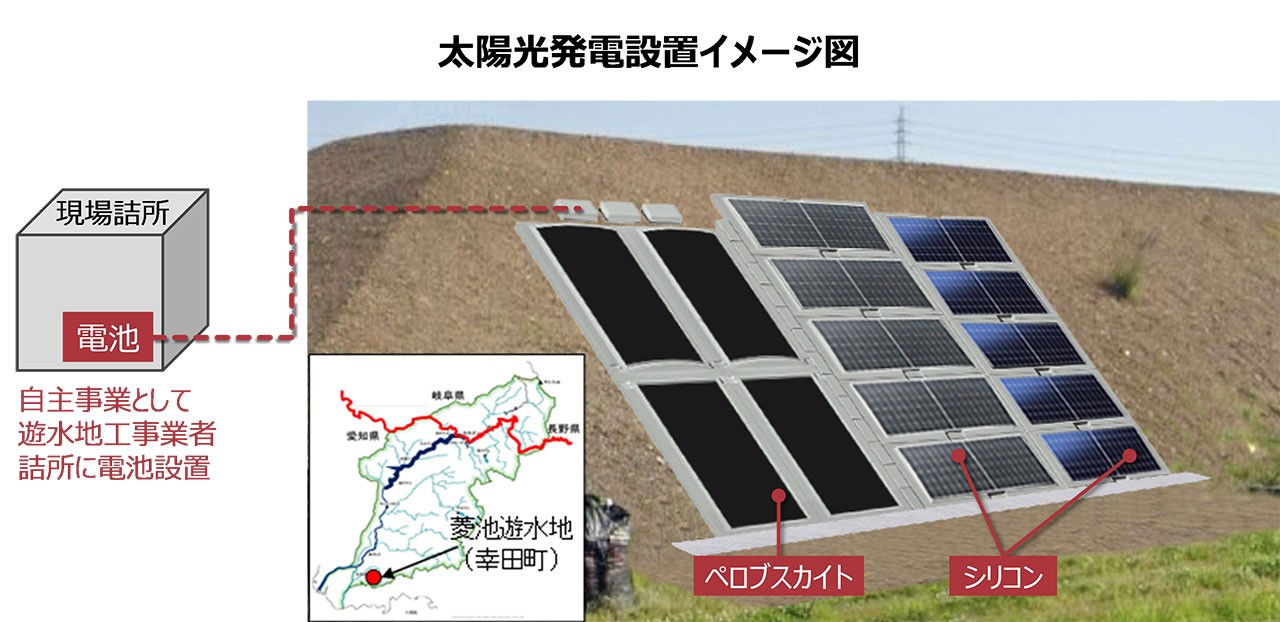
If the applicability to floodplain levees is confirmed through demonstration experiment, it could also be applied to the slopes of rivers, dams, reservoirs, etc., greatly advancing the spread of renewable energy in water infrastructure spaces. PACIFIC CONSULTANTS will establish a method for introducing renewable energy into solar power generation at water infrastructure facilities, and by expanding the scope of application to various water infrastructure facilities, such as levees, dam slopes, and reservoir water surfaces across Japan, we will contribute to the realization of a decarbonized society.



